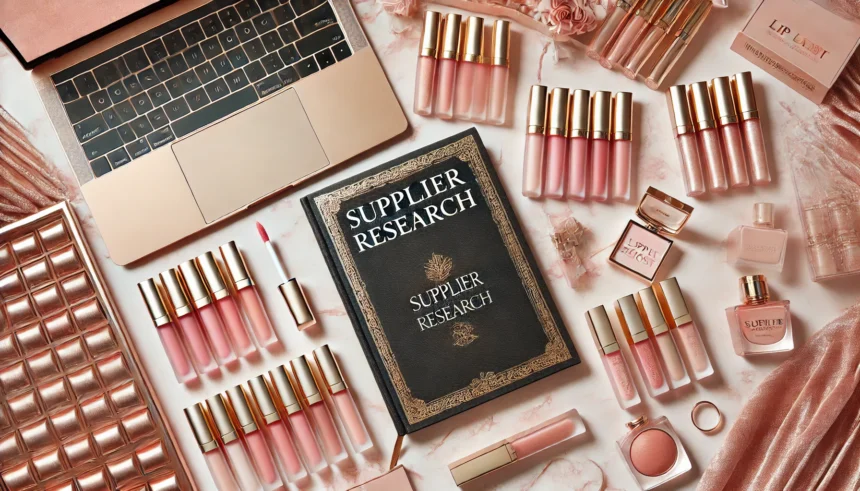Starting a lip gloss business can be an exciting venture in today’s thriving beauty market. However, one of the most crucial steps in launching your brand is finding reliable suppliers for your lip gloss products. This comprehensive guide will walk you through how to find suppliers for a lip gloss business, helping you source high-quality ingredients and packaging that align with your brand vision.

Understanding Your Needs
Before embarking on your search for suppliers, it’s essential to clearly define your needs. Understanding your product requirements will streamline the sourcing process and ensure you partner with the right suppliers.
1. Identify Product Ingredients
Start by outlining the specific ingredients you want to include in your lip gloss formulations. Consider the following components:
- Base Ingredients: These form the foundation of your lip gloss. Common choices include:
- Oils: Such as coconut oil, jojoba oil, or castor oil for moisture.
- Waxes: Beeswax or carnauba wax to provide texture and stability.
- Emulsifiers: To blend oil and water-based ingredients seamlessly.
- Colorants: Choose safe pigments and dyes that give your lip gloss its unique shades. Ensure these are approved for cosmetic use.
- Flavorings: Natural or synthetic flavors can enhance the sensory experience. Consider options like vanilla, mint, or fruit flavors.
- Additives: Ingredients like vitamin E, shea butter, or aloe vera can add nourishment and benefits to your lip gloss.
2. Determine Packaging Options
The packaging of your lip gloss is just as crucial as the product itself. Consider these factors:
- Container Types: Explore options like squeeze tubes, doe-foot applicators, or pots. Choose based on your target market’s preferences.
- Labeling: Custom labels should reflect your brand identity. Think about materials and designs that align with your branding.
- Shipping Materials: Plan for how you’ll package and ship your products, considering protective packaging to avoid damage during transit.
Steps to Find Suppliers for a Lip Gloss Business
1. Conduct Online Research
The internet is a treasure trove for finding suppliers. Here are key platforms to explore:
- Supplier Directories: Websites such as Alibaba, ThomasNet, and Maker’s Row provide extensive listings of suppliers across various industries. You can filter your search based on location, product type, and minimum order quantities.
- Industry-Specific Websites: Look for databases that focus specifically on cosmetic suppliers, such as ChemWorld or Cosmetics and Toiletries. These sites often feature manufacturers that cater specifically to beauty brands.
- Social Media Platforms: Instagram and LinkedIn are excellent resources for discovering suppliers. Search relevant hashtags like #lipglosssupplier or #cosmeticmanufacturing to find potential partners showcasing their work.
2. Attend Trade Shows and Expos
Trade shows offer invaluable opportunities to meet suppliers face-to-face and build relationships. Consider attending events like:
- The Makeup Show: This professional trade show focuses on makeup and beauty products, featuring a variety of suppliers, manufacturers, and distributors.
- Cosmoprof: A global trade show for the beauty industry, Cosmoprof showcases suppliers for cosmetics, skincare, and hair care products.
- Beauty Expo: Local beauty expos may feature suppliers specializing in cosmetics and packaging, making it easier to connect with nearby partners.
3. Network with Industry Professionals
Building a network in the beauty industry can lead to valuable supplier recommendations. Here’s how:
- Join Beauty Forums and Groups: Participate in online forums or Facebook groups centered around the beauty industry. These communities often share experiences and recommendations for reliable suppliers.
- Attend Workshops and Seminars: Look for local or online workshops focused on cosmetic formulation or beauty entrepreneurship. Experts often share insights and supplier suggestions during these events.
4. Contact Manufacturers Directly
If you have specific manufacturers in mind, reach out to them directly. Prepare a list of questions to ask, such as:
- Minimum Order Quantities (MOQs): Understand the minimum quantities required to establish a business relationship.
- Pricing: Request detailed price lists and inquire about potential discounts for bulk orders.
- Lead Times: Confirm production timelines to ensure they align with your product launch schedule.
- Sample Products: Ask if they provide samples for you to evaluate the quality of their ingredients and packaging before committing to a larger order.
5. Evaluate and Compare Suppliers
Once you’ve gathered a list of potential suppliers, it’s time to evaluate and compare them based on several criteria:
- Quality of Products: Review product samples and test the lip gloss to ensure it meets your quality standards and aligns with your brand values.
- Reputation: Research the supplier’s reputation by reading reviews and testimonials from other customers. Consider reaching out to their previous clients for firsthand feedback.
- Pricing and Terms: Compare pricing structures, payment terms, and shipping costs. Be mindful of hidden costs or additional fees.
- Customer Service: Assess their responsiveness and willingness to address your questions or concerns. A reliable supplier should provide excellent customer service and support.

Building a Relationship with Your Suppliers
Once you’ve selected your suppliers, focus on cultivating a strong relationship. Here are some tips for success:
- Clear Communication: Maintain open lines of communication to discuss any issues or changes in orders promptly.
- Timely Payments: Ensure you pay invoices on time to establish trust and reliability, which can foster a positive working relationship.
- Feedback Loop: Provide constructive feedback on product quality and service. A good supplier will appreciate your input and work to enhance the partnership.
Utilizing Technology in Supplier Management
In today’s digital age, technology can streamline your supplier management process. Consider using:
- Inventory Management Software: Tools like TradeGecko or Cin7 can help track your inventory levels, automate reorder processes, and manage supplier information efficiently.
- Communication Platforms: Utilize tools such as Slack or Trello for real-time communication and project management with your suppliers. This ensures everyone is on the same page and can address issues quickly.
What to Do if You Encounter Issues
Even with diligent research, you may encounter challenges with your suppliers. Here’s how to handle common issues:
- Quality Discrepancies: If you receive products that don’t meet your standards, communicate your concerns directly with the supplier. Request replacements or refunds if necessary.
- Delivery Delays: If shipments are delayed, reach out to the supplier for updates. Establish a contingency plan to manage your inventory levels to minimize disruption to your business.
- Miscommunication: If there’s a misunderstanding regarding orders or specifications, address it promptly and respectfully. Clear communication can often resolve issues quickly.
FAQ – How to Find Suppliers for a Lip Gloss Business in 2025
Online directories (Alibaba, ThomasNet), trade shows, social media, and direct manufacturer contacts.
Check product quality, pricing, MOQs, lead times, and customer reviews.
Look for reviews, request samples, and verify certifications before committing.
Private label lets you customize products, while wholesale offers lower prices on existing formulas.
Conclusion: Finding Suppliers for a Lip Gloss Business
Finding the right suppliers for your lip gloss business is a critical step toward success. By understanding your product needs, conducting thorough research, attending trade shows, networking within the industry, and evaluating your options carefully, you can build a solid foundation for your brand.
Remember, the quality of your lip gloss products will ultimately reflect your brand’s reputation, so take the time to choose suppliers that align with your values and standards. With the right suppliers in your corner, you’ll be well on your way to creating a successful lip gloss line that stands out in the competitive beauty market.
Start your search today and bring your lip gloss vision to life! Your business dreams are within reach—partner with the right suppliers to make them a reality.








